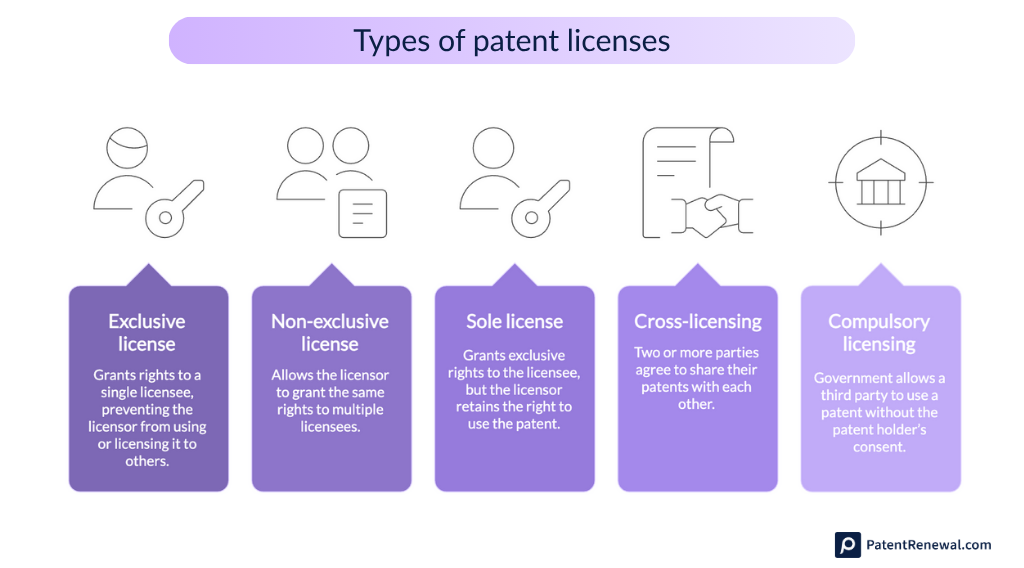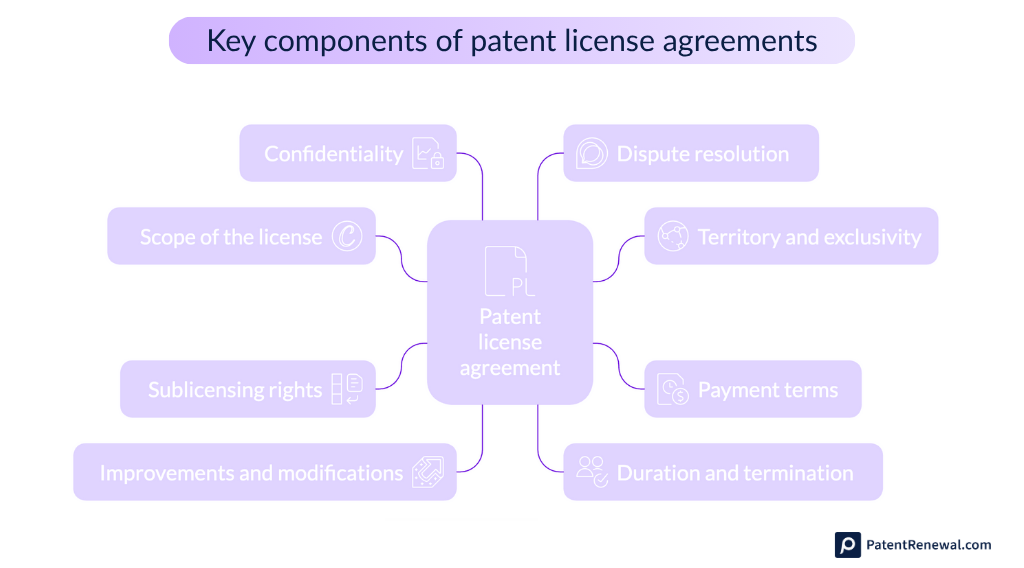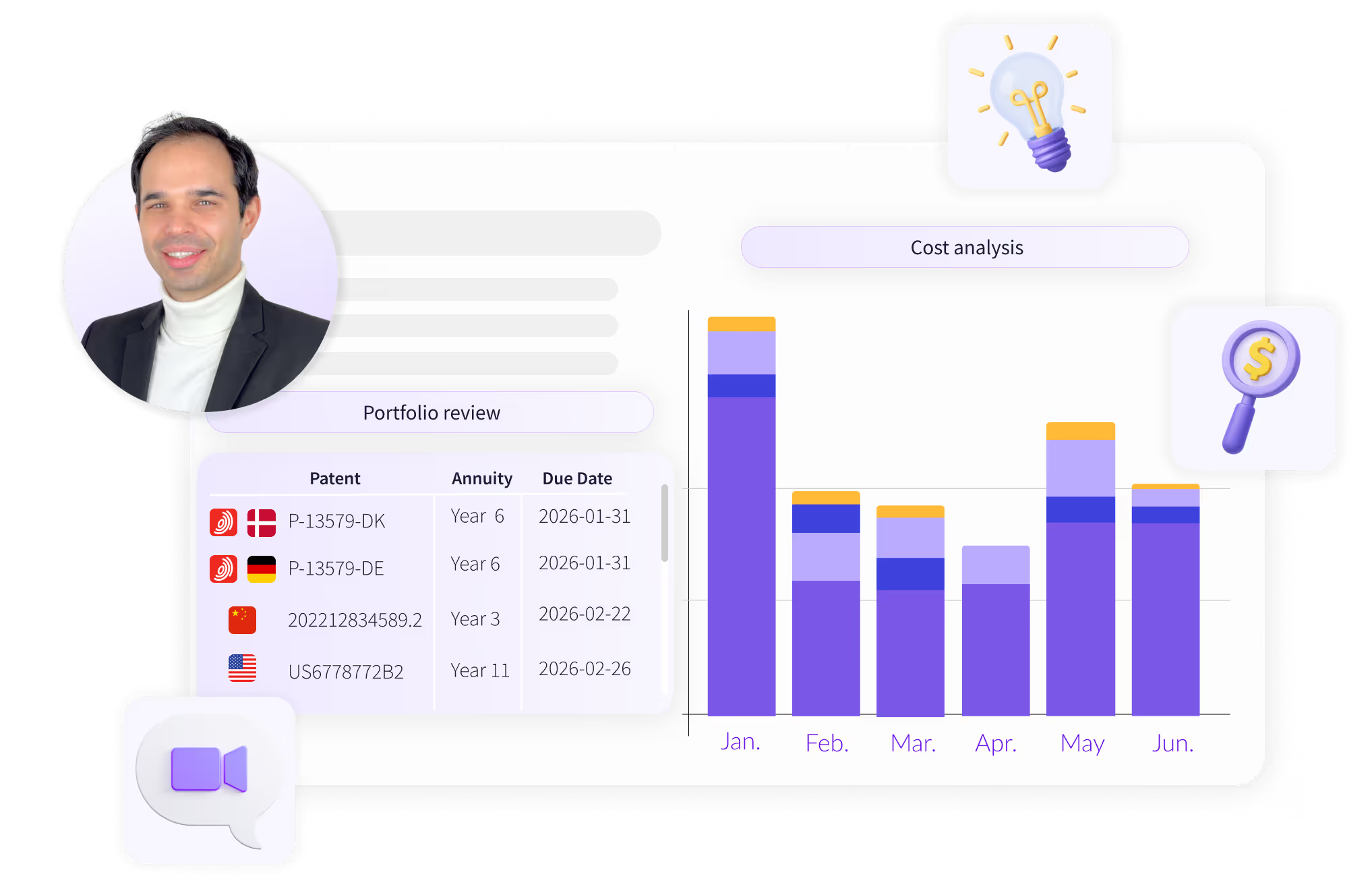TRY OUR NEW (FREE) IP RENEWAL COST CALCULATOR
Calculate.avif)
Patent licensing gives patent holders the ability to generate income, collaborate with partners, and expand into new markets without giving up ownership of their invention. Licensing creates opportunities for growth, innovation, and return on investment.
In this guide, we’ll walk through everything you need to know about patent licensing with insights and recommendations from legal experts. You’ll learn what it is, how it works, who’s involved, and how to structure a license agreement the right way.
We’ll also break down the risks, global considerations, and how licensing applies across industries from biotech to software. By the end of this article, you’ll understand how to approach patent licensing confidently and why managing your IP properly matters.
Patent licensing is when a patent holder gives someone else the legal right to use, produce, sell, or distribute their invention without giving up ownership. This permission is granted through a written agreement that outlines exactly how, where, and for how long the patent can be used.
The original owner (called the licensor) still holds the patent, but the other party (the licensee) gets to benefit from it under clearly defined terms. In return, the licensor typically receives payment, often in the form of royalties.
It’s important to know that licensing a patent is not the same as assigning it. Licensing means you’re sharing rights for a specific purpose or time. Assignment means you’re permanently handing over ownership. With licensing, the licensor continues to own the patent and often still benefits from its use, most commonly through royalty payments.
You can license different types of patents, including methods, processes, designs, and utility models. For example, a patented pharmaceutical formula can be licensed to a global manufacturer, while a patented mechanical part might be licensed to an automotive company.
Businesses license patents to commercialize their innovations, access new markets, collaborate with partners, and reduce the burden of going to market alone.
In short, patent licensing is a way to make your IP work for you without letting go of control.
Patent licensing is a strategic tool that helps organizations achieve larger goals. For some, it’s a way to generate revenue from underused patents. For others, it’s a method to enter new markets or form industry alliances.
Licensing is particularly useful in mergers and acquisitions. IP assets that are already licensed often have a higher value because they generate recurring income. Conversely, licensing patents before an M&A deal can help startups show traction and increase their valuation.
Patent pools, where multiple companies license their patents to each other or to a central administrator, allow industries to adopt common standards. This is common in telecommunications and streaming technology.
In university and research settings, tech transfer offices regularly license inventions to startups and established companies. This helps move innovations from the lab to the market while funding further research.
Here’s how to go from owning a patent to successfully patent licensing it:

“A license is only as strong as its enforceability. Companies often overlook the legal groundwork when rushing into a deal. That's a mistake. First, register your patents and ensure their claims are defensible. Weak patents equal weak leverage. Next, structure licensing terms to withstand legal scrutiny. Define royalty bases clearly. Include audit rights. Spell out what constitutes a breach. For inventors, this isn't just about upfront cash. Licensing can develop credibility, bring in investors, and open up new market avenues. But only if the deal safeguards your interests in the long run. Legal oversight isn't optional. Get help negotiating and drafting. A good contract now saves lawsuits later.” - Justin Lovely, Owner, Lovely Law Firm Injury Lawyers
Patent licensing involves several key players, each with specific roles and interests.
The two core parties are:
Other important stakeholders include legal advisors or patent attorneys, who draft and review the license agreement to protect both parties and ensure it complies with IP laws. In some cases, intermediaries like patent brokers or technology transfer offices help facilitate the patent licensing process.
For example, a university research lab might license a patented compound to a biotech startup that brings the drug to market. Or a tech company might license a software patent from an individual inventor to build it into their product line. Each scenario involves different motivations and outcomes, but the framework remains similar: sharing value without transferring ownership.
Not all patent licenses are the same. The type of license you choose will influence how your patent can be used, who can use it, and what kind of income or restrictions apply.
“If it is your first time entering a patent licensing agreement, choose your license type carefully because that single decision will shape everything else. You need to be very clear whether you are giving exclusive rights to one party or you are going to give access to the same patent to several parties on a non-exclusive basis. This will decide how much control you retain and how much flexibility you lose. If the license is exclusive, you grant a person all rights in a specific market or area, which may result in a larger initial fee, but will prohibit you from collaborating with other entities in that market.” - Allan Hou, Sales Director, TSL Australia
Here are the five most common types:
Exclusive license
In an exclusive license, the licensor grants rights to a single licensee and agrees not to use the patent themselves or license it to anyone else during the agreement period. This setup works well when the licensee plans to invest heavily in bringing the invention to market and wants full control within their chosen territory or industry.
A company patents a new solar panel coating and gives exclusive rights to a single manufacturer in Southeast Asia. The deal lets the manufacturer invest confidently in production, knowing no one else can use the technology in that region.
Non-exclusive license
Here, the licensor can grant the same rights to multiple licensees. This approach is common in industries like software and electronics, where standardization and wide use are desirable. A non-exclusive license enables broader distribution and potentially more royalty streams.
Sole license
This is a hybrid model: the licensee gets exclusive rights, but the licensor retains the right to use the patent as well. It’s often used when the licensor wants to continue using the invention in their own operations while allowing one external party to commercialize it.
Cross-licensing
In a cross-license, two or more parties agree to share their patents with each other. This is especially common in complex tech ecosystems like smartphones or telecom, where multiple patented technologies are needed to create a single product. Cross-licensing can help companies avoid infringement lawsuits while encouraging collaboration.
Compulsory licensing
This occurs when a government allows a third party to use a patent without the patent holder’s consent, typically for public interest reasons. A well-known example is the compulsory patent licensing of pharmaceutical patents during health emergencies to ensure public access to medicines.

A patent license agreement is a legally binding document that defines the rights and responsibilities of both the licensor and licensee. Both parties need to write the agreement carefully to avoid disputes and make sure they fully understand the terms. Key components include:

A strong agreement protects both parties and ensures the license supports the long-term value of the patent.
Licensing a patent is a business opportunity, but it also carries legal risks that must be managed from the start.
One of the first concerns is patent validity. If the licensed patent is later challenged and invalidated, the agreement might become worthless. That’s why it’s crucial to confirm the patent is enforceable in the relevant jurisdictions before entering a patent licensing deal.
There’s also the issue of freedom to operate. Even if you license a patent, using it in the market could still infringe on other existing patents. Both licensors and licensees need to assess the broader IP landscape to avoid unexpected litigation.
Infringement liability is another important point. If a licensee violates someone else’s patent rights while using the licensed technology, who bears the responsibility? The agreement must define liability and include indemnity clauses that protect both parties.
In some cases, antitrust laws come into play, especially when patent licensing affects competition. For instance, exclusive licenses or agreements tied to market dominance may be subject to scrutiny under antitrust or competition regulations. This is especially relevant in sectors involving standard-essential patents (SEPs), where patent licensing terms must comply with fair, reasonable, and non-discriminatory (FRAND) principles.
Another risk often overlooked is the financial stability of the licensee. Before signing, verify their ability to meet payment obligations by reviewing tax returns and financial statements—not just business plans. For smaller licensees, milestone or front-loaded payments can protect your cash flow and reduce the risk of missed royalties if the business struggles later on.
“From my investment advisor days, I learned that licensing deals need the same due diligence as securities transactions. Always verify the licensee's financial capacity through their tax returns and financial statements, not just business plans. I've seen too many promising licensing deals collapse because the licensee couldn't make royalty payments after year two. My CPA background taught me that milestone payments often work better than percentage royalties for small inventors. Front-loaded payments improve your cash flow and reduce collection risks, especially if you're licensing to startups or smaller companies that might not survive long-term market challenges.” - David Fritch, Attorney, Fritch Law Office
Patent rights are territorial, meaning they apply only in the countries where the patent is granted. For patent licensing agreements that span multiple regions, this creates complexity.
Each license must clearly define the jurisdiction it applies to. A license for a U.S. patent doesn’t automatically give rights in Europe or Asia. If the patent holder owns multiple versions of the patent in different countries, the license must include each jurisdiction separately.
International treaties, such as those administered by the World Intellectual Property Organization (WIPO) or the Agreement on Trade-Related Aspects of Intellectual Property Rights (TRIPS), provide some harmonization, but local enforcement still matters.
Additionally, some countries require registration of license agreements with local IP offices to be enforceable. Others have rules on royalty payments and taxation, which can affect the license’s financial terms.
Translation and legal localization may also be necessary, especially when dealing with partners across Asia, Latin America, or the EU.
Navigating international patent licensing requires a good understanding of global IP frameworks and local legal counsel in each key market.
Emerging fields such as artificial intelligence, biotechnology, clean technology, and advanced software are changing the way patent licensing works.
In AI and software, patents often protect algorithms, data structures, or user interfaces. These patents may involve hybrid protection with copyrights and trade secrets. Licensing in this space must carefully define scope and usage rights, especially as generative AI expands.
In biotech, companies license genetic sequences, drug delivery systems, or CRISPR-based innovations. Licensing allows startups to use university or lab-developed patents while raising funding and entering clinical trials.
Clean tech patents covering areas like solar power, battery storage, and sustainable materials are increasingly licensed as part of global climate initiatives. Governments and companies alike are collaborating through patent licensing to accelerate innovation and reduce emissions.
As innovation accelerates, licensing strategies must keep up with new technologies, ethical concerns, and cross-sector partnerships.
Patent licensing allows you to unlock value from your innovation on your terms. Whether you're looking to generate revenue, attract partners, or expand internationally, the right license agreement can help you get there without giving up control of your IP.
But to license your patent effectively, you need to keep it active and that means managing IP renewals reliably. That’s where we come in. At PatentRenewal.com, we help patent holders worldwide reduce their IP renewal costs by up to 50%, with our automated platform making IP renewals simple, secure, and transparent. Learn more about our service here.
Interested in a free IP renewal consultation? Benchmark your current IP renewal setup and costs against market standards.
